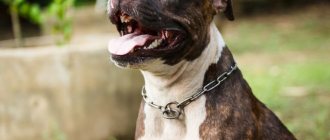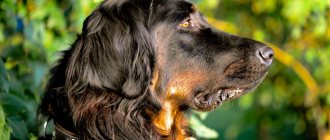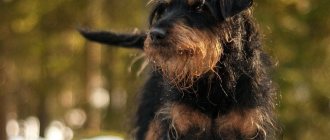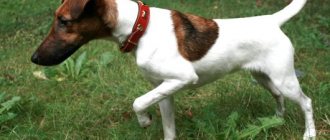11/29/2019 Irina Malinina 0 comments
The Fox Terrier dog is a small animal with an unusual and memorable appearance. Beady eyes, funny face and constantly flickering paws bring a smile. But don’t think that this is a comical and awkward baby. The Fox dog is a hunting breed, the threat of all burrowing animals.
The name of the dog originally contained its purpose. After all, from English fox is translated as fox, and terrier is translated as earth.
Hunting dogs could cope with any animal living underground, even if it was larger than them. They worked especially masterfully during fox hunting.
Fox Terrier dog - a brief description of the breed
There are two types of Fox:
- smooth fox terrier;
- Wire Fox Terrier.
Wire-haired representatives of the breed appeared only towards the end of the 19th century and were not as valuable as their smooth-haired counterparts.
It was believed that the smooth fox terrier was more dexterous in hunting, and its fur, which fit tightly to the body, did not get dirty at all during work. It is now prohibited to cross representatives of two varieties, although there was a time when this was not prohibited.
The Fox Terrier is a strong dog, despite its small stature. She is very energetic and courageous, balanced and at the same time has excellent reactions. Smart, quick-witted, cheerful, loves games and entertainment, and is also well trained.
Fox Terriers will not be happy with a passive couch potato. And a sedentary and leisurely owner will be horrified if he becomes the owner of such a dog.
The peculiarity of Foxes is that they have a negative attitude towards loneliness. You should not leave your beloved pet alone for a long time, so as not to witness the apocalypse at the moment of return, the epicenter of which is your living space.
Foxy is a small animal with the habits of a leader. Throughout his life, he will periodically try to take a leading place, relegating the owner to the background.
Foxes are lovers of barking. Residents of city apartments should take this into account. After all, excessive “talkativeness” of a pet can cause conflict with neighbors.
Brief breed information
Smooth Fox Terriers are a medium-sized dog breed bred to hunt small game, particularly foxes. Initially, the very name of these dogs came from their purpose - “fox” is translated from English as “fox”. That is, a fox terrier is a terrier that hunts foxes. Also, an adult fox terrier is capable of fighting such serious animals as a badger, raccoon dog, and large rodents.
The Fox Terrier has an excellent sense of smell and hearing, due to which they are used not only as hunters, but also as guards. Due to their modest size, foxes are not capable of being bodyguards, but they are quite capable of being responsible for the safety of property and territory. At a minimum, a sensitive fox terrier will warn of a stranger’s intrusion with a ringing bark.
Fox Terrier: a small but desperate and brave dog
A person should not be deceived by the small size and friendly expression of the fox terrier's face. In fact, they are fearless, fast and resilient dogs. Foxes have a stable psyche, an independent, energetic and uncompromising character, and they are extremely attached to people. But, the breed is not suitable for homebodies and those who prefer to spend their free time on the couch.
The Smooth Fox Terrier is a dog that cannot feel happy without regular physical activity, training, and long walks. If the animal is not taken out for hunting, this must be compensated for in other ways: by running, swimming, and studying various canine disciplines. Below we will talk about this in more detail.
Fox Terriers are not couch dogs!
History of appearance
The history of the breed begins in the British Isles. This is where fox terriers originate.
Initially, their mission was quite simple: they destroyed rodents and took part in the hunt for all the “little things” that lived in holes.
The fox terrier became popular in the 14th century, when the British became interested in burrow hunting and attracted foxes to this process. At that time, only smooth-haired dogs existed. Wire-haired foxies appeared much later.
For some time there have been deliberate matings between dogs with smooth coats and dogs with hard coats. The breeders had the goal of obtaining unique offspring.
Fox Terriers were identified as an independent breed only towards the end of the 18th century, when the British interest in fox hunting reached its peak. Dogs also began to shine at various exhibitions.
Photo: https://pixabay.com/photos/terrier-dog-snow-white-winter-pet-3981536/
1876 was the year the first standard was adopted.
Foxes came to Russia only in the middle of the 19th century.
Fox Terriers are observant and attentive animals. When hunting, they are distinguished by lightning-fast movements; they very quickly and at the same time deftly attack the animal, leaving no time for thinking. Such an excellent reaction saves the dogs’ lives and leaves no chance for the enemy.
Training at 3 months. Socialization
Three months is an important stage in a fox terrier puppy’s introduction to the outside world. Your first walks should be short and not too tiring for the puppy. You should start with 15 minutes, gradually increasing the walking time to 1 hour.
Correct formation of the nervous system
At this age, the puppy’s nervous system is forming.
. It has been proven that raising puppies in isolation during this important period contributed to the development of pronounced cowardice in them later. It is necessary to show the puppy as much as possible: noisy streets, large crowds of people, etc. Everything that he will have to face in later life.
This must be done very carefully, gradually, over and over again increasing the time spent in noisy places, so as not to overload the puppy or frighten him.
The territory of a country house, cottage or village are places with a minimum amount of external stimuli for a city dog. Therefore, if you plan to keep a dog in an urban environment, “growing up” a fox terrier puppy in such conditions depleted of irritants is unacceptable.
A city puppy must grow up in the city, in conditions that are saturated with external stimuli, such as: noisy streets, large crowds of people, other animals, birds, cyclists, cars, etc.
Meeting people and dogs
It is necessary to introduce the puppy to friendly dogs and people
so that later the puppy does not develop aggression or cowardice caused by the fear of new things and the inability to communicate and make new acquaintances. Currently, unfortunately, this is not uncommon in the behavior of adult dogs, but a fairly common problem with which people turn to our specialists for help.
Puppy behavior on the street
The emergence of new places leads to new rules that need to be consolidated:
- Now you can and should go to the toilet on the street, and not stoically endure it, carrying everything home;
- Not every new person or dog wants to communicate, so you don’t need to run headlong to meet everyone;
- Not all food is healthy, so it should only be taken from the owner’s hands.
Training and practicing commands
Training a puppy follows the same principles as at 2 months. It should be remembered that at this age puppies develop conditioned reflexes quite easily, but they are forgotten just as quickly, so you should not scold the puppy for not following commands, especially if they have not been repeated for a long time, but you should pay more attention to learning new things and repeating already covered material .
Dog appearance (standards)
Dimensions
With a height of 34-39 cm, the weight of fox terriers usually does not exceed 8.2 kg. Bitches are a little sleeker and lighter than males.
Wool
The Wirehaired Fox Terrier is distinguished by its wiry coat, which is 2-4 cm long. The dog’s “coat” is quite thick.
The smooth-haired representative of the breed has shorter hair. The hair of such a dog fits tightly to the body.
Colors
The most common color of the Fox is white in combination with spots and markings of black, as well as brown-red and black.
Head
The wedge-shaped head has a weakly defined transition from the forehead to the muzzle.
Both the dog’s muzzle and its skull are almost the same length.
Teeth and jaws
The jaws with white strong teeth close in a scissor bite.
Eyes
The Fox's eyes are round. They are planted not deep and not very far from each other, and are characterized by a dark color.
Body and limbs
The Fox Terrier has a strong, proportional build. A short loin, a straight back, a deep chest - these are his characteristics.
Limbs are straight. The hind ones have elongated massive hips.
Tail
The high-set tail should be carried straight and not curl unless docked.
The docked tail should also not fall to the side.
Rock defects
The defects include the following:
- soft, down-like wool;
- the presence of marks of an uncharacteristic color;
- lack of pigmentation on the nose;
- undershot;
- snack;
- drooping ears;
- cryptorchidism in males.
Fox Terrier Character
The Fox Terrier dog, like any other hunter, is very active, energetic, playful, and unrestrained. He needs education, because he is sure that the world revolves around him. The pet will try to take the place of the “leader” in his family.
Foxes are curious dogs.
They will not leave a single crack unattended and will not calmly pass by a new object. They generally believe that everything needs to be seen, examined, explored. Moreover, this quality is inherent not only in puppies; the dog will willingly take an interest in what is happening until a very old age.
Photo: https://pixabay.com/photos/terrier-dog-snow-white-winter-pet-3981535/ But it’s very difficult to say for sure about calm coexistence with other pets. It happens that Foxes get along relatively well with four-legged neighbors who live side by side with them. And it happens that they are not given a moment of peace. Among the representatives of the breed there are plenty of fighters and bullies.
Foxes are the most intolerant of their own kind. Most likely, they simply consider everyone their rivals.
Also, you should not house rodents next to the hunting breed; they are prey for foxes.
Fox Terriers have a “hobby” – digging holes. They can easily dig a huge pit in the middle of the yard. Apartment owners should not be happy that they have a laminated floor and not dirt, and the dog will not dig holes. Will! If she is deprived of a normal walk and does not know where to throw out the accumulated energy, the dog will begin to “dig” even the hard floor, and believe me, she will achieve success, and considerable success.
Representatives of the breed also love to chase any vehicle, from a bicycle to a tram.
The Fox Terrier dog breed is an active animal; no one will be bored with them. Such a pet will be especially appreciated by active people who do not like routine and leisurely activities.
The Terrier is a dog with excellent eyesight, scent and hearing.
Attitude towards the owner
The Fox Terrier is a master at distributing love among all members of the household. And at first glance it seems that the animal loves everyone equally. In fact, the dog singles out one owner from everyone, to whom the main flurry of the warmest feelings is intended. The Fox just needs a firm master's hand that will direct the dog's energy in the right direction or restrain it if necessary.
Representatives of the breed love to spend time with their owner and expect care and affection from him. And if they receive all this in the required amount, then in return they give only loyalty, devotion, positivity, becoming the most affectionate and devoted friend for a person.
Attitude towards children
Is it possible for families raising children to have a fox terrier? If the children are teenagers, then Foxy will be a great friend, will keep the kids company in any game or fun, and will be nearby even during more serious sports activities.
If the family is just growing up, it is better to avoid buying a representative of this breed. In addition to the fact that these dogs are very active and can accidentally knock a child down, they can also bite him deliberately if they feel threatened by the actions of a small person.
Attitude towards strangers
The Fox Terrier dog has proven itself as a watchdog. Innate fearlessness and a heightened sense of ownership make the dog a good guard.
It is unusual for dogs to show anger and aggressiveness towards people.
But they will defend their beloved family and entrusted territory, and very zealously. This is precisely where loud barking and the Fox’s love for this very singing come in handy.
Choosing a puppy: what to look for?
What should you pay attention to when choosing a Smooth Fox Terrier? Appearance, character of the parents, price - these are the main points that should guide you when looking for a puppy. You can find an advertisement on the Internet, there will be information about the parents, their photos, and a description of the litter. Some sellers even take videos of this breed to showcase their best qualities, whether for hunting or training.
If you need a puppy whose element is hunting, look at his parents and evaluate their qualities such as activity and anger. They play an important role. The price of such a puppy can be high.
You can purchase a puppy from a special nursery. On the Internet you can find the address of the nursery, as well as photos and videos of dogs.
The price of a puppy may vary depending on its pedigree. It can also be influenced by the dog's character. Thus, future hunting requires from the animal not only excellent physical data, but also a lively mind and quick wits - these qualities are why the price of a puppy increases. In general, the maximum price for representatives of this breed is about $500.
Whatever the price, by paying it, you acquire something that money cannot buy: a devoted and loving pet, an excellent hunter and a cheerful friend. The Smooth Fox Terrier is what novice dog breeders need. Minimum requirements for care and maintenance and maximum emotional return - these are the features of this breed, reviews of which are only positive. This is also a beautiful dog, as can be seen in the photo.
Care and maintenance
To keep this terrier, the best option would be a private house with a yard in which you can build a spacious enclosure. But, as practice has shown, Foxes also feel great in cities, living in small apartments. Of course, when their need for movement is completely satisfied.
Walks
Active walks will help make your dog well-mannered. Not only long walks are welcome, but also very intense ones. Keep your dog busy with running, swimming, games, jumping, learn commands, include intellectual exercises, and the pet will simply be grateful to you.
A dog that walks regularly and for a long time with its loved one will always be healthy and in excellent spirits.
Within the city limits, you should not let your four-legged pet off the leash.
The hunting instinct will cause the dog to chase a cat, a small rodent, or a passing car. The animal may get lost or injured while being chased by a vehicle.
Photo: https://pixabay.com/photos/fox-terrier-cute-dog-animal-pet-2871081/
During the cold season, you can dress up your pet in an elegant jumpsuit. And among the gloomy park a bright, restless ray will flash.
An animal that has not received attention and proper physical activity will definitely look for a way to throw out energy.
It will find him, damaging furniture and things, and the owner is unlikely to like it.
Hygiene
Hygienic procedures to which fox terriers are subjected do not, as a rule, cause any difficulties.
The dog needs to wipe its eyes weekly to remove traces of souring, and inspect its ears to rid them of natural wax secretions.
Usually an active dog wears its claws down while walking outside, but if this does not happen, you need to trim them at least once a month using special nail clippers.
Twice a month you will have to brush your pet's teeth using toothpaste and a pet brush for this purpose. All necessary supplies for caring for your pet can be purchased at a pet store.
It is not recommended to bathe your dog often; 3-4 times a year is quite enough. But you will have to wash your paws more often, especially after walks in rainy weather.
Use special wax in winter to protect your paws from exposure to chemicals.
The baby needs to be taught hygiene procedures from the first days, otherwise the grown-up puppy will not allow incomprehensible manipulations to be carried out on him.
Feeding
Fox Terriers are food lovers. For this reason, you need to carefully control the portion size and not overfeed your four-legged pet so that it does not turn into a calf.
It is easier to solve this problem if your fox eats dry food. It is enough to follow the recommended dosage of food and place a bowl of clean water in the dog’s access area.
When feeding naturally, you need to feed your dog only approved foods, removing all harmful ones from your pet’s diet. Recommended foods include the following: lean meat, beef offal, low-fat fermented milk products, eggs, cottage cheese, herbs, seasonally collected vegetables and fruits, porridge.
It is recommended to give the animal a weekly “fasting” day. On such a day, the fox terrier can only eat crackers (rye), fresh carrots and water.
Dogs that eat natural food should be given vitamin and mineral supplements in the fall and spring.
Grooming
The Smooth Fox Terrier may not be as elegant as its wire-haired cousin, but it does not require as much grooming. It is enough to brush such a pet only once a week, and maybe less often.
The Wire Fox Terrier needs trimming - plucking the hairs.
If this procedure is not done, the fox will begin to gnaw out dead hairs with its teeth or comb them out with its paw, injuring itself.
Trimming should be done at least twice a year, and ideally three or four times. The first time the procedure can be performed in the salon, and in the future it can be done independently.
Fox Terriers cannot be cut. This makes their fur soft and thin.
Feeding rules
The food of fox terrier puppies should be rich in building materials necessary for the growing body. 2/3 of the diet should be meat and fish, one third should be vegetable proteins.
Adequate nutrition is impossible without fiber contained in porridges (rice, buckwheat, oatmeal) and vegetables (cabbage, carrots, zucchini and pumpkin). The puppy begins to be fed additionally at the age of 3 weeks, at 1.5 months he is fed 5-6 times a day, gradually reducing the number of meals. An adult dog is fed twice a day.
There are foods that are contraindicated for pets. These are, first of all, sweets that can cause diabetes. You should also not give canned food, pork, legumes and potatoes. Seasonings and spices should be avoided in the diet.
Nutrition is an important component in keeping and caring for a dog. Good nutrition is the key to health and longevity, as well as activity and a positive mood for your pet.
Education and training
All dog breeders know the expression that if you don’t educate an animal, it will begin to educate its owner. To avoid this, you need to devote enough time and attention to training a new family member.
The first “lessons” should not last more than 15-20 minutes, as gambling dogs are restless. It is better to conduct classes in the form of a game, then everyone will be interested: both the owner and his four-legged pet. Gradually the dog will get used to the discipline, and it will be easier to work with it.
The Fox Terrier dog is an average learner, and certain difficulties will certainly arise in the process.
Be that as it may, the pet needs to be taught to respond to its name, go to the toilet only in the designated place, be calm about the leash and collar, know basic commands and obey the owner.
Foxes are gourmets. This weakness of theirs must be exploited by treating the dog with some tasty treat after correctly executing the command.
It is better to start training when the dog has run around to its heart's content.
The animal will become calmer and concentrate its attention on work.
Photo: https://pixabay.com/photos/dog-smooth-fox-terrier-terrier-1308949/
Particular attention should be paid to curbing the hunting instincts of the Fox. A dog going out for a walk must have decent behavior and listen to its owner. Of course, sometimes the fox terrier will “break” the roof. And then the dog will rush as fast as he can to the representative of the cat family, who for some reason has lost his vigilance. But you shouldn’t judge your four-legged friend harshly, because everyone can have small weaknesses.
You should not treat the “four-pawed” dog while the family is having dinner.
Fox will decide that he can feast with everyone at any time and will jump on the table in the midst of this process. And the dog has excellent jumping ability.
Training at 4 - 5 months
By this time, the fox terrier puppy has already become accustomed to your home and usual walking areas, and no longer needs your support and care so much. He begins to flirt with other dogs, pretend that he does not hear you when you call him, and show a certain persistence and disobedience when performing various commands.
This means it's time to move on to full training . In classes at this age you can already be persistent and demanding. At the same time, the most important thing is not to overdo it, remember that classes should bring joy to both you and your dog, and only then you can achieve the desired result.
Required commands in 4 months
What commands are practiced in a fox terrier puppy at 4 months:
- Calm movement next
to the owner with and without a leash, with landing when stopping, with a change in pace and direction of movement - Return to you
on command - Exposure
in a free or certain position (sitting, lying, standing) - Indifferent attitude towards treats scattered on the ground
- Inhibitory command
to stop unwanted actions - Execution of a set of commands “sit”, “lie down”, “stand”
at a distance and near the leg, when giving commands by voice and gestures - Stop barking
on command.
Health
Representatives of the breed are not sickly and very often live happy and vibrant lives, visiting the veterinarian's office only to get a routine vaccine.
But there are a number of diseases to which the Fox is predisposed. Among them are the following:
- epilepsy;
- deafness;
- eye diseases;
- diabetes;
- myasthenia gravis;
- Perthes disease.
Foxes are prone to food allergies.
Therefore, experimenting with introducing unfamiliar foods into your pet’s diet should be done very carefully.
Fox Terriers must be vaccinated! They are very sensitive to infectious diseases.
Before each scheduled vaccination, your pet needs to be dewormed and then carried out once a quarter.
You can feed your dog both natural food and special food.
It is advisable to include the following products in the fox terrier's diet:
- Boiled meat (lamb, chicken, veal).
- Porridge (buckwheat, oatmeal, rice).
- Carrots and pumpkin.
- Boiled fish without bones.
- A small amount of fruit.
- Lactic acid products (ryazhenka, kefir, Varenets).
You can add a small amount of vegetable oil to the finished portion of food. When choosing dry food, you should take into account the health and age of the dog. Make sure your pet always has access to clean water.
How to choose a Fox Terrier puppy
Before you go to the kennel, you need to decide for yourself what kind of puppy you need: a future hunter, a champion, or just a baby for the soul.
Some nurseries breed hunting foxes, while others breed show foxes.
You need to take your baby home when he reaches 2 months of age. If a puppy is under 1 month of age, most likely there is something wrong with it, and an unscrupulous seller is trying to get rid of the baby before the defect becomes noticeable. Or maybe he just wants to save money on maintaining a pack of puppies.
Photo: https://pixabay.com/photos/dog-fox-terrier-meadow-garden-2868507/
When purchasing a show puppy, be sure to study its pedigree.
Find out more about your parents' progress. After all, if they have not become podium stars, then their baby is unlikely to achieve high results.
When buying a representative of the hunting line, check with the puppy’s parents about the presence of hunting diplomas.
The future hunter must have a docked tail.
After all, the tail is the most vulnerable place of an animal, especially when hunting in a hole. And in any case, you will have to trim it yourself, if the breeder did not do this. And these are additional worries, and even at an older age, the dog endures this procedure more difficultly.
Choose only a healthy puppy, without signs of disease, with clean ears, eyes and shiny fur. Take the one you like. And it’s even better if the sympathy is mutual.
The breeder must willingly answer all questions, explain incomprehensible points, show the necessary documents upon request, and be interested in the future fate of the baby. If he behaves this way, it means that this is a responsible person, the owner of a good nursery, and your choice will definitely be successful.
Breeding
The pet is ready for breeding at 12-14 months. Early pregnancy and childbirth have a negative impact on the health of the female and offspring. Experts recommend mating at the age of two, after the third heat. They breed healthy, strong individuals with suitable breed characteristics. The time and place are agreed upon in advance. Usually the meeting takes place on the dog's territory. Before mating, dogs are prevented from helminths (worms).
Pregnancy can be confirmed by a veterinarian. In the early stages, the signs are invisible. Later, the dog becomes calmer, rests more, and its appetite increases. She needs increased nutrition.
Childbirth occurs in 55-65 days. They usually pass without complications, but supervision is necessary. The mother feeds the puppies on her own. In the absence of mother's milk, complementary feeding from a bottle is required. The young animals develop quickly and gain weight. Babies need age-appropriate vaccinations and tail docking.
How much does a dog cost?
The offspring of dogs with titles or excellent external characteristics can be purchased for 25-35 thousand rubles. A pet that does not claim to be an exhibition winner can be bought for 15-17 thousand.
Sometimes you can see an advertisement for the sale of an adult Fox, and the prices for such a dog are low. You can, of course, take a risk and save money. But experts do not advise doing this. After all, the fox terrier becomes very attached to its first owner and may simply not recognize another person when changing his place of residence.
Interesting Facts
- Fox Terriers were kept by Albert Einstein, Maxim Gorky, Charles Darwin and English kings;
- In the American resort town of Coronado (Costa Rica), dog surfing competitions are held annually. The winners of these competitions are often fox terriers;
- The canine department of the Russian Ministry of Emergency Situations actively uses fox terriers to search for people who are trapped under rubble or disappeared in the mountains;
- Fox terriers often became heroes of literary works (the story “Three in a Boat, Not Counting the Dog”, the children’s book “The Diary of Fox Mickey”, the cycle of stories “Dasha, or the story of a puppy’s life”);
- There are organizations in England that train fox terriers to collect donations that go to charitable causes.
- Fox Terrier George from New Zealand sacrificed his life to save young children from angry pit bulls.
Pros and cons of a dog
Let's look at the positive aspects of the Fox Terrier:
- excellent hunter;
- high intellectual indicators;
- ability to get along with children;
- love for all household members;
- devotion;
- positive;
- overflowing energy;
- ease of care.
Negative sides:
- loves to bark often and loudly;
- restless;
- shows aggressiveness towards other four-legged animals;
- creates certain difficulties during training if it does not recognize the owner as a leader.
Behavior
Fox Terriers are active at any age. With the appearance of such a pet in the apartment, the owners will have to fall in love with an active lifestyle. Otherwise, the fox terrier will look for an outlet for energy inside the apartment.
Another quality of the Fox Terrier to consider: the dog loves to dig. Therefore, we must at least give her this opportunity during a walk. Then the floor in the apartment will be more intact. You should not leave your fox terrier alone at home for a long time. He will be nervous and try to calm himself down with his favorite pastime: digging.
The Fox Terrier is a big fan of barking, loudly, loudly and for a long time. It is almost impossible to force or train him to remain silent. This is not the best quality for an apartment in a multi-storey building.











